Sunday, July 28, 2002
A brisk clear morning! There was hardly a cloud
in the sky and my body was eager to soak up the sun. The view out
of our railcar window was nothing short of spectacular! We took showers
and then hit the road. We loved our stay at Whistle Stop Lodging
and I would give my unqualified recommendation to anyone visiting Seward.
We cruised the railroad's car shop which services the
passenger car fleet. As cruise ship passenger patronage of the Alaska
Railroad continues to grow, we should see future expansion of this car
shop.
Burger King sounded like a safe breakfast stop.
Unfortunately, the teenage girl who took our order was actually a I-really-don't-want-to-be-here
food Nazi. The most revealing moment occurred when she made an error
at the cash register and ordered her boss to come fix it. Heated
words were exchanged and she finally ended the argument by telling her
boss to "bite me!"
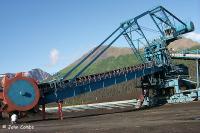 Before
we departed Seward, we went on a short Alaska Railroad photographic safari.
We visited the loading facility that loads railroad delivered coal into
huge ocean freighters bound for Korea. Unfortunately, this loading
operation will soon cease now that Korea has located cheaper sources of
coal on the world market. Our final Seward photos were of the cruise
ship, flat car loads and some old orphaned McKinley Route box cars now
used as storage trailers.
Before
we departed Seward, we went on a short Alaska Railroad photographic safari.
We visited the loading facility that loads railroad delivered coal into
huge ocean freighters bound for Korea. Unfortunately, this loading
operation will soon cease now that Korea has located cheaper sources of
coal on the world market. Our final Seward photos were of the cruise
ship, flat car loads and some old orphaned McKinley Route box cars now
used as storage trailers.
Shortly after leaving Seward, we caught the southbound
Coastal Classic at an underpass and at scenic Snow River Bridge.
[Note: My video of this can be found on my videos
page - #04 and #08 respectively] As I pulled away from
the bridge, I noticed the gas gauge was practically on empty. I felt
pretty stupid having to return to Seward to fill up the gas tank.
Adding injury to insult, I overflowed the gas tank trying to get an extra
eight cents in. I have never fueled a car that overflowed so easily.
The drive to Whittier
was beautiful as well as uneventful. We arrived at the Anton Anderson
Memorial tunnel just before 11:00 p.m. Due to massive protests from
the residents of Whittier, the toll had been reduced to $12.00 for cars.
After waiting for several minutes, our lane got the green light and we
drove through the longest highway tunnel in North America, a length of
2.5 miles, and entered into the wonderful world of Whittier. [Note:
My video of driving into the tunnel can be found on my videos
page - #10]
For beginner's only: "In
1941, the U.S. Army began construction of the railroad spur from Whittier
to Portage. This line became Alaska's main supply link for the war effort...
On April 23, 1943 workers completed the spur, which consisted of a 1 mile
tunnel through Begich Peak and a 2.5-mile tunnel through Maynard Mountain,
thus linking Whittier to the Alaska Railroad's main line at Portage. With
a new rail connection to Whittier, the area began to change. In the mid-1940s,
work crews and supply ships began to arrive, and population, including
military and civilian personnel, swelled to over 1,000. Infrastructure
- such as buildings (including the six story Buckner building and the Begich
Tower), a power plant, and a petroleum tank farm - began to change the
landscape. The 1950s brought change to Whittier once again. As the
military pulled out, Whittier transformed into a federally run commercial
port... Whittier has been a port on the Alaska Marine Highway, but its
only link to Alaska's highways was via the Alaska Railroad. The Alaska
Railroad began offering a shuttle service between Portage and Whittier
in the mid 1960's. This unique form of rail service allowed vehicles
to drive on to flat cars to be transported between Whittier and Portage...
As the numbers of people traveling to and from Whittier increased, so did
the demand for more convenient and affordable passage to Whittier...
After studying all the options, [it was] determined that the best solution
was to construct a highway to Maynard Mountain and transform the existing
railroad tunnel into a one lane, combination highway and railway tunnel
that allows cars and trains to take turns traveling through the tunnel...
Construction began in September 1998 and was completed in May 2000" --
from the Anton
Anderson Memorial Tunnel web site.
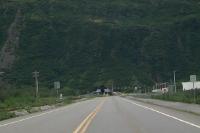 |
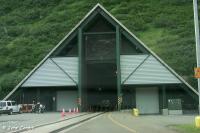 |
| View of Bear Valley portal and mountain |
Close up of portal thru car windshield |
As we emerged from the darkness of the tunnel, I noticed
a little bit of sun peaking through the clouds. This was good news
since Whittier is known for its nasty weather. You can enter the Bear Valley
portal under partly cloudy skies and emerge from the Whittier portal to
horizontal rain. The ocean and mountain range creates a truly unique
weather system.
Excerpt from John's Alaska Railroad
2000 Trip Journal: "I have never encountered any town as unique as Whittier.
Their phone book doesn't even cover an entire page. They have 30
to 50 school children meaning your high school graduating class would have
two to three members. That is if your parents didn't decide to send
you off to Anchorage instead. There is basically one street in town
and a handful of businesses. But the thing that makes them really
stand out is virtually all the residents live in the Begich Towers apartments.
This World War II era building survived the 1964 earthquake plus the resulting
tsunami. Another apartment tower is nearby, but the Army chose not
to repair it after the earthquake. The weather is fairly dreary three
fourths of the time and rumor has it that alcoholism is rampant. "
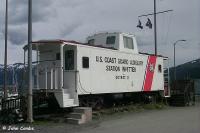 The
Coast Guard caboose was our first stop. Caboose 1076 was donated
to the Whittier Coast Guard Auxiliary in September 1999. The Coast
Guard refurbished and painted the caboose and then opened it to the public
in July 2001. I was dismayed to find it uninhabited and the doors
locked. We took some photographs of it and then headed to the rail
yard.
The
Coast Guard caboose was our first stop. Caboose 1076 was donated
to the Whittier Coast Guard Auxiliary in September 1999. The Coast
Guard refurbished and painted the caboose and then opened it to the public
in July 2001. I was dismayed to find it uninhabited and the doors
locked. We took some photographs of it and then headed to the rail
yard.
As we approached the Whittier shuttle, we saw engineer
Billy Hightower reclining in locomotive no. 2002 and reading a newspaper.
He was killing time until his 6:00 p.m. return trip to Anchorage.
Billy plans on heading to Montana when he retires in four years.
This is one of the typical retirement plans for a lot of Alaskans.
Either retire in the mountains (Montana, Colorado, etc.) or to the closest
milder climate (Washington) or to someplace where they never have to see
snow again (Nevada, Arizona, Florida).
Railroad employee John Kennedy (no relation to our past
president) and his crew was also in the yard. They were neither reclining
nor reading the newspaper. Instead, they were cutting weeds along
the tracks to satisfy the visiting Federal Railroad administration folks.
I asked him if he had any good stories he could share with me for posting
on my web site. "I've got a lot of good stories, but I can't share
any of them with you."
The railroad exchanges freight with the lower 48 states
via ocean barges. As part of the new Lynden barge delivery contract,
the railroad is building a new dock. Randy and I stopped by to get
a few pictures of it and found there wasn't very much to see yet.
To satisfy my "land of the lost" urge, we paid a visit
to the abandon Buckner
building. We pulled in at the back of the building and found a small
garage with two mattresses in it. This must be quite the teen playhouse
on weekend nights! Since we didn't see any "No Trespassing" signs,
but admittedly we weren't looking for any of them, we entered the building.
There was a lot of spray painted graffiti on the walls, broken glass, tetanus
infested metal on the floor, and stalactites having from the ceiling.
Some of the rooms (including the basement) were inaccessible due to deeper
water and/or total darkness. Water dripped from the ceilings of many
of the rooms and I assume the roof probably doubled as a pond. We
eventually found the old movie theater and did the best we could on getting
a few photographs in the pitch black room. We carefully explored
all six floors looking for remnants of the operating room, bowling alley,
officer's lounge and hobby shop. From the top floor you get a great
view of the whole town. The rest rooms still had some sinks, urinals
and toilets. The mess hall offered a fine selection of grass and
moss on the floor. One room even had the original green paneling
on it. All and all, the building appeared structurally sound.
Not too shabby for a building that survived one of the world's largest
earthquakes
plus nearly 40 years of utter abandonment. Next time I explore this
gem I will be wearing boots and carrying a retina melting flashlight.
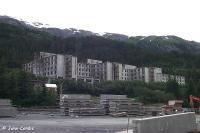 |
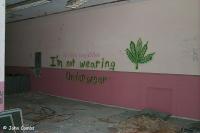 |
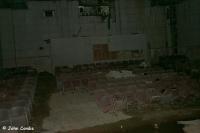 |
| Buckner bldg. housed troops in WW II |
Interesting graffiti adorn the walls |
Seats are still intact in the movie theater |
 |
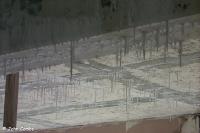 |
 |
| Some walls gone, but paneling's still there |
Mineral stalactites having from ceiling |
Grass and moss on the dining hall floor |
By now we had definitely worked up and appetite so we
stopped at the Anchor Inn for some fish (Halibut) and chips. The
chips (French fries) weren't very good, but the lightly breaded Halibut
was far superior to that which I got at fancy Ray's restaurant in Seward
and was almost half the price.
Before getting back in the car, we walked around taking
pictures of the old fire station, Lynden trailers, flat cars, an old mechanical
reefer and the Begich Towers building where the vast majority of Whittier
residents live. We also paid a visit to the new pedestrian tunnel
which enables people to walk under the railroad yard instead of through
it. Since the area gets tens of feet of snow in the winter, I wonder
what will keep massive amounts of snow from drifting shut the entrances
to this tunnel.
Whittier Pedestrian Tunnel
 |
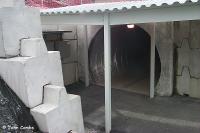 |
 |
| Walkway, Anchor Inn and GP38 2002 |
Entrance |
Interior |
As we were leaving Whittier, we stopped one more time
at the Coast Guard caboose. The fickle finger of fate once again
blessed us with good luck as the caboose was open and guard member Steve
Sterling was inside. Steve and I had been communicating over the
past couple of years via email. I provided him with historical information
about the caboose while he provided me with photos in its new Coast Guard
paint scheme. He showed us an historical display he created using
my information and photos from my web site as well as stuff from other
sources.
 At
5:00 p.m. sharp we were at the Whittier tunnel portal just in time for
immediate departure through it. Emerging on the other side, we took
photos of the track, rail bridge and portal in Bear Valley. I got
the crazy idea of photographing the train as it crossed the as it crossed
the small rail bridge in Bear Valley. Randy pointed out that our
time would be better spent photographing the train as it crossed Twenty
Mile Bridge. This had been a goal of mine so I readily agreed. Since
we'd have some spare time on our hands, we stopped at the Portage yard
and hiked approximately two miles down the line to photograph some on box
and tank cars.
At
5:00 p.m. sharp we were at the Whittier tunnel portal just in time for
immediate departure through it. Emerging on the other side, we took
photos of the track, rail bridge and portal in Bear Valley. I got
the crazy idea of photographing the train as it crossed the as it crossed
the small rail bridge in Bear Valley. Randy pointed out that our
time would be better spent photographing the train as it crossed Twenty
Mile Bridge. This had been a goal of mine so I readily agreed. Since
we'd have some spare time on our hands, we stopped at the Portage yard
and hiked approximately two miles down the line to photograph some on box
and tank cars.
 Arriving
at Twenty Mile Bridge, I set my video camera on the hood of the car and
got my digital cameras ready. About twenty minutes later the train
crossed the bridge and I had my prized shot. I just wish it had been
a sunny evening! [Note: My video of this can be found on my videos
page - #01] We chased the Whittier shuttle up the line snatching
pictures of it along the way. At Bird Point it met a south bound
freight and I captured the moment on both video as well as digital stills.
Arriving
at Twenty Mile Bridge, I set my video camera on the hood of the car and
got my digital cameras ready. About twenty minutes later the train
crossed the bridge and I had my prized shot. I just wish it had been
a sunny evening! [Note: My video of this can be found on my videos
page - #01] We chased the Whittier shuttle up the line snatching
pictures of it along the way. At Bird Point it met a south bound
freight and I captured the moment on both video as well as digital stills.
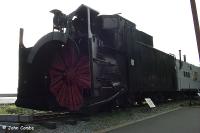 We
made a brief stop at Potter for photos of the station house, snow rotary
(at left), troop sleeper, gas powered MOW car and some new interpretive
display boards. We returned to Don's condo around 9:00 p.m.
He was anxious to hear tales of our adventures so we spent a couple of
hours hitting the highlights. After Randy and Don headed for bed,
I sorted my digital photos and added to my journal until midnight.
We
made a brief stop at Potter for photos of the station house, snow rotary
(at left), troop sleeper, gas powered MOW car and some new interpretive
display boards. We returned to Don's condo around 9:00 p.m.
He was anxious to hear tales of our adventures so we spent a couple of
hours hitting the highlights. After Randy and Don headed for bed,
I sorted my digital photos and added to my journal until midnight.
Previous Chapter | Main
| Next Chapter
 Before
we departed Seward, we went on a short Alaska Railroad photographic safari.
We visited the loading facility that loads railroad delivered coal into
huge ocean freighters bound for Korea. Unfortunately, this loading
operation will soon cease now that Korea has located cheaper sources of
coal on the world market. Our final Seward photos were of the cruise
ship, flat car loads and some old orphaned McKinley Route box cars now
used as storage trailers.
Before
we departed Seward, we went on a short Alaska Railroad photographic safari.
We visited the loading facility that loads railroad delivered coal into
huge ocean freighters bound for Korea. Unfortunately, this loading
operation will soon cease now that Korea has located cheaper sources of
coal on the world market. Our final Seward photos were of the cruise
ship, flat car loads and some old orphaned McKinley Route box cars now
used as storage trailers.














